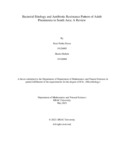| dc.contributor.advisor | Hasanuzzaman, Md | |
| dc.contributor.author | Eusra, Kazi Fatiha | |
| dc.contributor.author | Shehrin, Shaira | |
| dc.date.accessioned | 2023-10-01T06:20:41Z | |
| dc.date.available | 2023-10-01T06:20:41Z | |
| dc.date.copyright | 2023 | |
| dc.date.issued | 2023-05 | |
| dc.identifier.other | ID 19126005 | |
| dc.identifier.other | ID 19126060 | |
| dc.identifier.uri | http://hdl.handle.net/10361/21406 | |
| dc.description | This thesis is submitted in partial fulfillment of the requirements for the degree of Bachelor of Science in Microbiology, 2023. | en_US |
| dc.description | Catalogued from PDF version of thesis. | |
| dc.description | Includes bibliographical references (pages 41-43). | |
| dc.description.abstract | This article reviews literature focused on Community Acquired Pneumonia (CAP), Hospital
Acquired Pneumonia (HAP) and Ventilator Associated Pneumonia (VAP) in adults published over the years of 2004 to 2021. The review was performed to identify the etiological agents of adult pneumonia and antibiotic resistant pattern in the South Asian region with the intention of determining the local etiology of pneumonia in order to make proper choices regarding empirical antibiotic treatment. Among 27 studies included, 17 were conducted in India, 4 in Bangladesh, 4 in Pakistan and 2 in Nepal. A total of 11 studies presented antibiotic resistance data along with etiology. Gram-positive organisms were more prevalent in CAP than HAP, according to information on the causative organism. However, in both HAP and CAP cases, gram-negative organisms outnumbered gram-positive organisms. Each CAP study carried out in India, Nepal, and Bangladesh revealed that Streptococcus pneumoniae was the most frequent causal agent. Moreover, Klebsiella pneumoniae was the most frequent bacteria observed to cause HAP and VAP. There was a considerably greater level of resistance to third-generation antibiotics among the major causative agents in cases of VAP compared to CAP. To combat the expanding concern of antibiotic resistance, more comprehensive research on CAP, HAP, and VAP is required in South Asia. | en_US |
| dc.description.statementofresponsibility | Kazi Fatiha Eusra | |
| dc.description.statementofresponsibility | Shaira Shehrin | |
| dc.format.extent | 43 pages | |
| dc.language.iso | en | en_US |
| dc.publisher | Brac University | en_US |
| dc.rights | Brac University theses are protected by copyright. They may be viewed from this source for any purpose, but reproduction or distribution in any format is prohibited without written permission. | |
| dc.subject | Adult Pneumonia | en_US |
| dc.subject | South Asia | en_US |
| dc.subject | Antibiotic | en_US |
| dc.subject | Resistance | en_US |
| dc.subject | Etiology | en_US |
| dc.subject | Bacteria | en_US |
| dc.subject.lcsh | Pneumonia | |
| dc.title | Bacterial etiology and antibiotic resistance pattern of adult pneumonia in South Asia: a review | en_US |
| dc.type | Thesis | en_US |
| dc.contributor.department | Department of Mathematics and Natural Sciences, Brac University | |
| dc.description.degree | B. Microbiology | |

